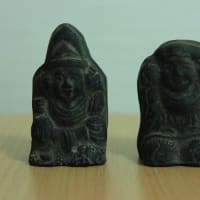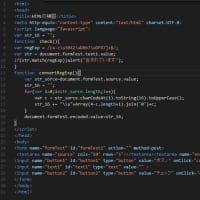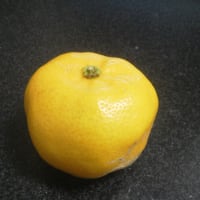もし1パケットに1バイトのデータしかないパケットを作られて4Gbyte以上のデータを転送するDoSやそれに類するものは発生しないのか今日の朝考えた。
今日は書きこむのは朝だけにしようと思う。
時間をつぶしてしまう。
昔、ハーディワインベルク則という対立遺伝子の規則の式を改造して各々の対立遺伝子に生存率や増殖率の係数を加えたことがあったが、それよりはセルで計算した方が個体間の距離という重大な問題が考えられて良い気がしたのでそっちにしたが先人はいっぱいいた。
考える必要もないくらいかもしれないと思った。
記事が載っていたりして、同じ分野で知っている人間の論文が入っていないとパージされているのかと勝手に病的なことを冗談半分で口走ったが、時折冗談でない人がいる。
多かれ少なかれ、皆、統合失調症である。
皆でおかしいと言ったらだれでも強制入院(大学院ではない)出来るほどおかしく見えるのは間違いない。
イオンがべん毛の動く直接原因でないとファインマンのブラウン・ラチェットの話をしたがなぜか皆表情が渋い。
詳しく計算が出来るわけではないが、基本動作原理がこれであると書いてあった気がする。
他にもイオン濃度を厳密に測定していない疑惑やエネルギー勾配を考えていない疑惑や違うシグナルカスケードのメジャーになりそうな記事を見つけて、失敗による穴埋めが効かない期間の思い出とともに手の動きを重くしている。
「虚仮にする」という言葉があるが、人の約束を守らなくていいぐらい貶めるようなことをすることであるらしい。
出来るのは知っていても、私から利益が取れないと考え、それを実行するだけの相手になってしまったのがどうも解せないし悔しかった事がある。
何が利益か不利益か対話することなしに相手を破壊することの方が利益が上がる場合が今となっては多いが、その利益も手に取ったり見えるものでなくなっている場合があるので、環境を悪化させる要因にもなるかもしれない。
出来るのさえ知っていてはいけないし、それを実行して利益が上がる環境にいてはならないのでそれを知っている相手は自分より劣った人間であるとみなして攻撃していいという理屈が成り立つのは、比較的論理的なのだが、確かに甘い気がする。
普通に話しの中でその感じを出すことは重要な場合もあるのだが、本格的な攻撃を語ってはいけないようだ。
メモ:ご飯の時間に規則を破った。
<header>
「ひかり電話」のVoIPアダプタに249日間の連続稼働で発着信不能になる不具合
NTT東日本および NTT西日本の「ひかり電話」で、「VoIPアダプタを電源投入後約8ヶ月(249日)間連続して利用すると、ひかり電話の発着信ができなくなる」という、バグが発見された(Nikkei Net、NTT東日本のニュースリリース、NTT西日本のニュースリリース)。NTT東西では7日にもアップデートを行うことを明らかにしている。
問題があるのは「PR-200NE」「RT-200NE」「RV-230NE」(NTT東日本)と「AD-200NE」(NTT西日本)で、合計約126 万台(東日本120万台、西日本6万台)。ファームも複数のバージョンにまたがっており、電源投入後249日(約8ヶ月)連続使用すると発着信が出来なく なるというもの。なお、8ヶ月連続使用する以前にファームのバージョンアップをしたり、電源アダプタの抜き差しを行っていた場合にはそこで日数も一旦リ セットされる。
(つづく...)
また、Anonymous Coward曰く、
症状からは、起動時に0からスタートし10msecごとに1つずつアップしていく32ビット符号ありの変数のカウンタが存在し、そのカウンタ変数のオーバフロー時に問題が生じていると推測できます。 Linux、Windowsの497日問題など、このようなオーバーフローバグの事例は多いです。バグになるという認識が浸透していないのでしょうか。
なお、値x、yの大小比較をオーバフローを考慮して比較するには、x、yが符号ありintか符号なしintのどちらかの場合、((int)(x-y))と0との大小比較を行う実装方法があります。
Scientists Create World's Tiniest Ear

Have you ever wondered what a virus sounds like? Or what noise a bacterium makes when it moves between hosts? If the answer is yes, you may soon get your chance to find out, thanks to the development of the world's tiniest ear. The "nano-ear," a microscopic particle of gold trapped by a laser beam, can detect sound a million times fainter than the threshold for human hearing. Researchers suggest the work could open up a whole new field of "acoustic microscopy," in which organisms are studied using the sound they emit.
The concept of the nano-ear began with a 1986 invention known as optical tweezers. The tweezers use a laser beam focused to a point with a lens to grab hold of tiny particles and move them around. They've become a standard tool in molecular biology and nanotechnology, helping researchers inject DNA into cells and even manipulate it once inside. Optical tweezers can also be used to measure minuscule forces acting on microscopic particles; once you've grabbed hold of your particle with the laser beam, instead of moving it yourself, you simply use a microscope or other suitable monitoring apparatus to watch whether it moves of its own accord. That's where the nano-ear comes in.
Sound waves travel as a forward and backward displacement of the particles of the medium they pass through. So to detect sound, you need to measure this back-and-forth motion. Optical physicist Jochen Feldmann and colleagues in the Photonics and Optoelectronics Group at the University of Munich in Germany used a particle of gold 60 nanometers in diameter, immersed in water, and held in optical tweezers.
Feldmann's team recorded and analyzed the movements of this particle in response to acoustic vibrations caused by the laser-induced heating of other gold nanoparticles in the water nearby. As well as having unprecedented sensitivity, their nano-ear could also calculate the direction the sound had come from. They suggest three-dimensional arrays of nano-ears working together could be used to listen in on cells or microorganisms such as bacteria and viruses, all of which emit very faint acoustic vibrations as they move and respire. "There are definitely medical opportunities which we can tackle together with the right people," Feldmann says, "but we just have to see how it works first."
Biophysicist Lene Oddershede of the Optical Tweezer Laboratory at the Niels Bohr Institute in Copenhagen is impressed and suspects the paper will inspire others in the field to look for sound waves when studying microorganisms. "It's a really interesting idea, and we could easily do that, but we have never made any attempt to do so," she says. "I would say this paper's very inspiring in that sense." She cautions, however, that the experimental setup will need to be significantly refined to improve its ability to separate sound waves from random molecular movement before the suggested acoustic microscope can become a reality. But she is optimistic: "I do believe they can relatively quickly improve the equipment."
私はコンピュータと、「呪詛」を趣味にしています。
やっていることは基本的にクロスコンパイルやクロスプラットホームで特定のOSや言語に依存していません。
呪詛というものは、日常的に目にするもの対する捉え方を多少変化させることで、基本的にゲシュタルト崩壊や錯視、概念導入、エビングハウスの忘却曲線、さらにはスペクトラム拡散など考えながら遊びに使ったものです。
道祖神のような自然物を広告・看板する類のものです。
小学校5年から今まで
・UNIXコマンドで任意多倍長計算の出来るbcコマンドを用いた重複を許したオイラー関数を使用する円順列や数珠順列の組み合わせの数を出力するプログラムの作成。(多くなると解けないということになっているが公式を論文から引用してコンピュータを使って32個の組み合わせまで解いた。RSA暗号と少し性質を同じくする。)
・日常的に見えるもののカウント。
・文字の出現頻度のリスト作成。
・エビングハウスプログラムの作成。




















※コメント投稿者のブログIDはブログ作成者のみに通知されます